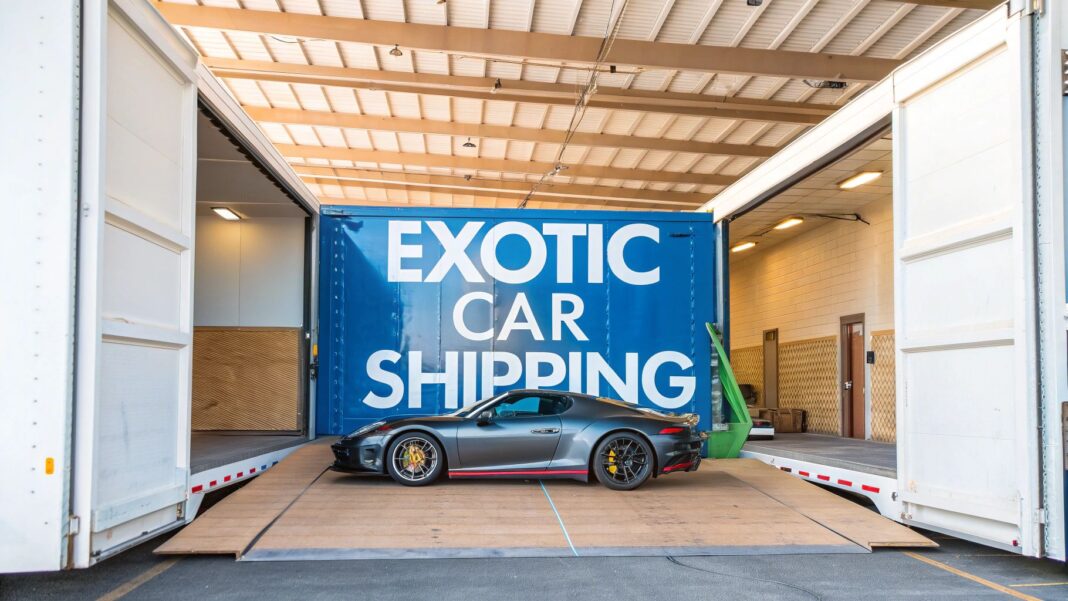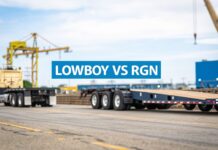
Shipping a high-value car is a nerve-wracking experience. It's not just a car; it's an investment, a piece of art, a passion. That's precisely why exotic car transportation isn't just a service—it's a critical step in asset protection. This is the white-glove experience your vehicle deserves, with every detail managed to ensure it arrives exactly as it left.
This guide provides actionable strategies to protect your investment, whether you're moving it across the state or across the country.
Why Specialized Transport Is Non-Negotiable
When you're dealing with an exotic, classic, or luxury car, standard shipping methods introduce unacceptable risks. Your vehicle is a major financial and emotional asset, and placing it on a standard open-air carrier is a gamble you can't afford to take.
Open carriers are suitable for daily drivers, but they leave a high-end vehicle exposed to flying rocks, road debris, harsh weather, and potential theft or vandalism. For a vehicle with a pristine finish or rare status, those risks can lead to costly repairs and diminished value.
This is where true exotic car transport proves its worth. You wouldn't mail a priceless painting in a standard envelope; it requires climate control, custom packaging, and careful handling. Your car demands the same specialized care: a controlled environment and handlers who understand its unique requirements and value.
Moving Beyond Standard Shipping
Unlike a run-of-the-mill car shipment, exotic transport is built on precision and absolute protection. These services are engineered to mitigate every possible risk, because even a minor scratch or paint chip can result in thousands of dollars in repairs and devalue your vehicle.
This guide is your roadmap to a seamless, stress-free shipping experience. We will provide actionable insights you can use immediately, from decoding transport methods and shipping quotes to preparing your car for its journey.
By understanding the details that matter, you can make sure your vehicle gets the first-class treatment it deserves, from the moment it’s picked up to the second it’s delivered.
What You Will Learn in This Guide
This guide is structured to build your confidence and knowledge, enabling you to select the right shipping partner and protect your investment. We’ll take a deep dive into:
- Transport Methods: A detailed analysis of enclosed vs. open carriers, helping you weigh security against cost.
- Cost Factors: A practical breakdown of what influences your shipping quote, so you can budget effectively and avoid surprises.
- Insurance Essentials: A step-by-step guide to verifying coverage and ensuring your asset is fully protected.
- Preparation and Delivery: Actionable checklists for pre-shipment prep and final inspection to safeguard against disputes.
Let's start with the most important decision you'll have to make.
Choosing Your Transport Method: Enclosed vs. Open
When shipping your exotic car, the first critical decision is choosing between an enclosed or an open carrier. This is a strategic choice about risk management, not just cost.
An open carrier leaves your vehicle exposed to every road hazard: rain, sun, dust, and flying debris. For a daily driver, that’s an acceptable trade-off. But for a supercar with a flawless finish and minimal ground clearance, those everyday risks carry significant financial consequences.
The Gold Standard: Enclosed Transport
For any high-value vehicle, enclosed transport is the only recommended option. It functions as a mobile garage, completely sealing your car from the outside world. This method is your best defense against weather, road debris, and unwanted attention. If you own a supercar, a classic collectible, or a luxury EV, this is the only way to guarantee security.
There are several types of enclosed shipping, each offering a specific level of care:
- Hard-Sided Carriers: These offer maximum protection from impacts and the elements with rigid walls. They are often equipped with climate control and hydraulic lift gates specifically for low-clearance vehicles.
- Soft-Sided Carriers: These trailers use heavy-duty, tear-resistant curtains instead of solid walls. They provide excellent protection from weather and debris but are a step down in security from hard-sided options.
- Single-Car Haulers: For ultimate white-glove service and discretion, a single-car enclosed trailer is unparalleled. Your vehicle receives the driver's full attention, often resulting in faster, more direct transit.
The demand for this level of protection is growing. The enclosed car transportation market is projected to hit $6.15 billion in 2025, a clear sign that owners are prioritizing asset protection. You can discover more insights about the enclosed transport market growth and what's driving it.
Key Takeaway: Treat the cost of enclosed transport as an investment in preservation. The premium you pay is an insurance policy against damage that could easily cost far more to repair, both in terms of money and diminished vehicle value.
Understanding Open Carrier Transport
While enclosed shipping is the correct choice for exotics, it's useful to understand the alternative. Open carriers are the multi-level trucks commonly seen on highways. They are a cost-effective choice for standard vehicles.
The primary benefit is price. By hauling up to 10 vehicles at once, the cost per car is significantly lower. However, this comes with risks unacceptable for a high-end car: exposure to road debris, fluid leaks from vehicles on the top deck, and a complete lack of security from theft or vandalism.
For an exotic car owner, the choice is clear. If your vehicle has a low front splitter, delicate carbon fiber components, or a six-figure paint job, the financial gamble of open transport is not worth the savings.
Here’s a quick breakdown to help you compare the two options side-by-side.
Enclosed vs. Open Carrier At a Glance
| Feature | Enclosed Transport | Open Transport |
|---|---|---|
| Protection Level | Complete protection from weather, debris, and theft | Exposed to all elements and road hazards |
| Vehicle Capacity | Typically 1-3 vehicles per truck | Up to 10 vehicles per truck |
| Cost | Higher price per mile | More budget-friendly |
| Best For | Exotic, classic, luxury, and high-value cars | Standard sedans, SUVs, and daily drivers |
| Equipment | Often includes hydraulic lift gates and soft tie-downs | Standard ramps for loading and unloading |
Ultimately, the table highlights the trade-off: cost versus total peace of mind.

While you'll pay more per mile for enclosed transport, you are purchasing a significantly higher level of security and risk mitigation.
Decoding the Cost of Exotic Car Shipping
Understanding your exotic car transportation quote is about recognizing the value behind the price. The final number is a breakdown of the entire logistical plan, and knowing the components allows you to assess the service accurately.
Several key factors determine your final cost. These variables directly reflect the time, resources, and specialized care required to move your car safely.
The Core Pricing Factors
The primary factor is distance. Shipping a car from Miami to Los Angeles will cost more than a shorter trip. However, the specific route is equally important. High-traffic routes between major cities are generally more affordable due to carrier availability. Transporting a car to or from a remote, rural area will increase the price, as the driver must deviate from standard routes, adding time and mileage.
Seasonality also significantly impacts pricing. The auto transport industry experiences peak seasons. The annual "snowbird" migration sees high demand for routes from northern states to Florida and Arizona in the fall and the reverse in the spring. Summer is also a peak period for moves and car shows.
Actionable Tip: If your timeline is flexible, shipping during the off-season can result in significant savings. Booking at least 4-6 weeks in advance is crucial if you must ship during a peak period to secure a reputable carrier.
Vehicle and Service Specifics
The vehicle's specifications are a key factor. A larger, heavier vehicle like a luxury SUV takes up more space and weight, increasing the cost. If your car is inoperable, the carrier will require a winch for loading, which adds to the bill.
The service level you select directly impacts the quote. As established, enclosed transport is the mandatory choice for exotics. This premium service costs more than open transport, but the security it provides is essential for protecting a high-value asset.
You also need to select a delivery method:
- Door-to-Door Service: The carrier picks up and delivers your vehicle as close to your specified addresses as is legally and safely possible. This is the standard for convenience in exotic car shipping.
- Terminal-to-Terminal Service: You drop off and pick up the car from a central storage facility. While it can be slightly cheaper, the added logistics and potential for damage at the terminal make it unsuitable for high-end vehicles.
Market Forces and Surcharges
Broader economic factors also influence your price. Fuel cost is the most common variable, and most quotes include a fuel surcharge that adjusts with market prices. This is a transparent way for carriers to manage real-world operating costs.
Supply and demand is another powerful force. The global luxury car market is projected to reach $1.11 trillion by 2032, according to one in-depth luxury car market report. This growth increases demand for specialized transport services.
To see how these factors translate into real numbers, consult this guide on how much it costs to ship a car to another state.
Navigating Insurance for Total Peace of Mind

For exotic car shipping, insurance is the ultimate safety net. A reputable carrier backs their safety claims with comprehensive, verifiable coverage that protects your investment from pickup to delivery.
It's critical to understand that your personal auto policy is generally not in effect while your car is being transported as cargo. The primary coverage is the carrier's cargo liability insurance. This makes verifying their policy a non-negotiable step in your due diligence.
How to Verify a Carrier's Coverage
Treat insurance verification as a deal-breaker. Never accept a company's word for it. Before signing any contract, you must confirm that their policy is active and the coverage amount is sufficient for your car's full value. A professional company will provide this documentation readily.
The essential document is the Certificate of Insurance (COI). This official proof from the insurer details the policy limits and effective dates. For complete certainty, request that the COI be sent to you directly from the insurance provider, not as a copy from the transport company.
A Certificate of Insurance issued directly by the insurer is the only way to be 100% certain the policy is legitimate and currently active. A copy provided by the broker could be outdated or altered.
This simple step ensures you have current, valid information. If a company is hesitant to provide a COI or facilitate contact with their insurer, consider it a major red flag and find another provider.
Critical Questions You Must Ask About Insurance
Once you have the COI, review it carefully and ask targeted questions to understand the scope of protection.
Use this checklist during your vetting process:
- What is your total cargo liability limit? This amount must exceed your vehicle's appraised value. Standard enclosed carriers may offer $250,000 in coverage, but premier exotic haulers often carry policies of $1 million or more.
- What is your deductible? Confirm if there is a deductible and who is responsible for paying it in the event of a claim. The correct answer is a $0 deductible policy for the customer.
- Are there any exclusions? Ask specifically what their policy does not cover. Common exclusions can include "Acts of God" (like tornadoes) or damage to highly customized aftermarket parts.
- Does the policy cover diminished value? If your vehicle is damaged and repaired, its market value may decrease. Ask if their policy compensates for this loss. This is a rare but valuable feature.
Getting clear answers to these questions provides a complete picture of your protection. For a deeper analysis of policy types, learn more about how auto shipping insurance works.
What to Do If the Unexpected Happens
In the rare event your vehicle is damaged, the Bill of Lading (BOL)—the inspection report signed at pickup and delivery—is your most critical piece of evidence.
If you discover any new damage upon delivery, you must note it on the BOL before signing it and before the driver leaves. This action officially documents the issue. Immediately take clear, well-lit photos and videos of the damage from multiple angles.
With this evidence, contact the transport company immediately to initiate the claims process. They will guide you through their procedures, which will require submitting the documented BOL, your photos, and repair estimates from a certified shop.
Your Pre-Shipment Preparation Checklist
https://www.youtube.com/embed/eVG9OOYyxpE
A smooth transport experience begins with proper preparation. Preparing your exotic car is a critical step to protect your investment, prevent delays, and ensure a seamless handover. This prep work is your first line of defense in the unlikely event of a claim.
Document Everything Meticulously
Before transport, create an undeniable record of your vehicle's current condition and value. Start by obtaining an exotic custom car appraisal. This provides a professional, third-party valuation that is essential for confirming adequate insurance coverage.
Next, use your smartphone to document the car's pre-shipment condition. This evidence is crucial.
- Walk-around Video: Record a slow, detailed video of the entire car. Capture the exterior from all angles, then the interior, under the hood, and a brief view of the undercarriage.
- Detailed Photos: Take high-resolution photos of every body panel, wheel, and any existing imperfections, no matter how minor. Get close-ups of any known paint chips or scuffs.
- Time Stamps: Ensure your photos and videos are time-stamped. This serves as definitive proof of the car's condition at the moment of handover.
Prepare the Vehicle for Transit
With documentation complete, prepare the car for transport according to standard carrier requirements, which are designed for safety and efficiency.
First, remove all personal items. This includes sunglasses, phone chargers, toll transponders, and any loose items. The carrier's insurance does not cover personal belongings.
Next, ensure the gas tank is at no more than a quarter full. This is a mandatory safety regulation to reduce vehicle weight and fire risk. The car only needs enough fuel to be driven on and off the carrier.
Finally, conduct a visual inspection for any fluid leaks. If you notice fresh drips of oil, coolant, or other fluids, inform the shipping company immediately. A carrier may refuse to load a leaking vehicle to prevent damage to other cars on the trailer.
Special Considerations and Final Checks
Exotic cars often have unique features requiring special attention before shipping.
Retract antennas, fold in mirrors, and secure any loose parts. For convertibles, ensure the top is fully latched. If your car has an adjustable spoiler or suspension, set it to the lowest or "transport" setting.
The rise of high-performance EVs like Tesla, Lucid, or Taycan introduces new protocols. With US EV exports increasing over 300% recently, experienced shippers are adept at their handling. Lithium-ion batteries require adherence to strict safety rules.
For an EV, activate "Transport Mode" if available to conserve the battery by shutting down non-essential systems. The battery should be charged to between 40-60%. A fully charged or depleted battery can pose a safety risk during transport.
Mastering the Pickup and Delivery Process
The entire exotic car shipping process hinges on two key moments: the initial inspection at pickup and the final inspection at delivery. Both are governed by one critical document: the Bill of Lading (BOL).
The BOL is not a simple receipt; it is a legally binding contract and a detailed condition report. It serves as the official "before and after" record of your vehicle. At pickup, you and the driver will inspect your car together, meticulously noting every existing imperfection on the BOL, from a small rock chip to a faint scuff on a wheel. This initial inspection is your most important action. Your signature on the pickup BOL confirms the vehicle's condition before it is loaded.
The Pickup Inspection
When the driver arrives, you must conduct a thorough inspection. Compare the vehicle's condition against your own pre-shipping photos and videos. As the driver notes imperfections, be present to ensure every detail is recorded.
Insist that every mark, no matter how minor, is documented on the Bill of Lading.
This joint inspection establishes a clear, agreed-upon baseline. This is not about being difficult; it is about ensuring transparency that protects both you and the carrier.
Only sign the BOL after you are fully satisfied that it accurately reflects your car's condition. The driver will provide you with a copy; keep it in a safe place.
The Final Delivery Inspection
Upon arrival, repeat the exact same inspection process. This time, your objective is to identify any new damage that may have occurred during transit. Before the driver leaves and before you sign anything, perform a comprehensive final check.
Use your copy of the pickup BOL as a checklist, comparing the vehicle in front of you to the original report. For more detailed guidance, these exotic car transportation tips offer a valuable resource.
Follow this action plan for the delivery inspection:
- Compare Against the BOL: Systematically inspect the car, comparing each panel and surface to the notes on the initial report.
- Use Good Lighting: Perform the inspection in daylight if possible. If it is dark, ask the driver to move the car under a streetlamp or use a high-powered flashlight.
- Note Any New Issues: If you find a scratch, dent, or scuff not listed on the original BOL, you must write it on the final document before you sign.
- Take Photos Immediately: Document any potential new damage with clear photos from multiple angles while the driver is still present.
Signing the final BOL without any new notations legally confirms that the car arrived in the same condition it was picked up in. By properly documenting any issues, you preserve your right to file an insurance claim.
Frequently Asked Questions About Exotic Car Shipping

Even with thorough research, practical questions often arise before booking. Addressing these final details ensures a completely stress-free shipping experience.
How Far in Advance Should I Book My Transport?
For the best rates and carrier availability, book your transport 2-4 weeks in advance. This is especially important for specialized enclosed carriers.
If shipping during peak season (summer or along "snowbird" routes in fall/spring), extend this lead time to 4-6 weeks. While last-minute shipping is sometimes possible, it will almost always cost more and limit your choice of top-tier carriers, who are often booked solid.
Can I Track My Vehicle During Transit?
Yes. Any reputable exotic transport company must offer GPS tracking. This is a standard, non-negotiable feature for high-value shipments.
Most providers offer a web portal or app for real-time tracking. Before booking, ask for specifics: Is it a live map, or are updates provided upon request? Clarifying this ensures you receive the peace of mind you are paying for.
Tracking isn't just a feature; it's a fundamental part of white-glove service. Real-time visibility of your asset's location is the modern standard for professional auto transport.
What Is the Difference Between a Broker and a Carrier?
Understanding this distinction is crucial as it directly impacts your shipping experience and who is responsible for your vehicle.
Here’s the breakdown:
- A carrier owns the trucks and employs the drivers. They are the company physically handling and transporting your vehicle.
- A broker is a logistics specialist. They manage a large, pre-vetted network of carriers and match your specific needs (route, vehicle type, timeline) with the best-suited carrier.
Working with a reputable broker offers significant advantages. They perform the due diligence for you—vetting carriers, verifying insurance, and checking federal operating authority and safety records. Most online transport companies operate as brokers. Ask them upfront to ensure you understand their role in the process.
When you're ready to give your prized vehicle the professional care it deserves, trust the experts. We Will Transport It brings over a decade of experience to the table, managing every logistical detail for high-value shipments nationwide. We pride ourselves on secure, reliable, and transparent service.
Get your free, no-obligation quote today and see what a difference our experience makes. Learn more at We Will Transport It.





